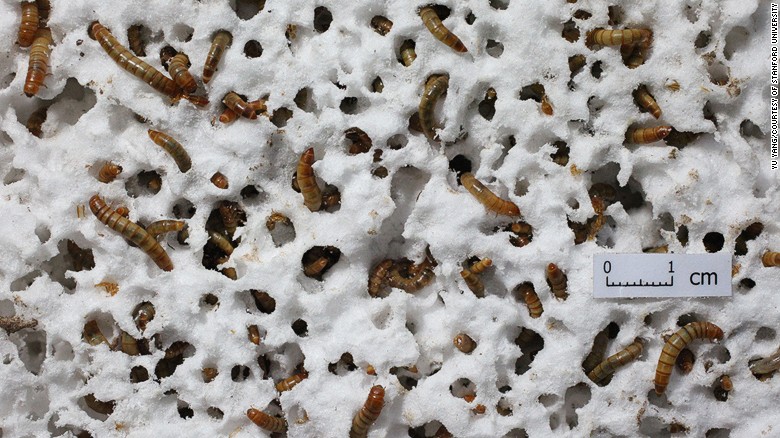Right now Styrofoam is the enemy. It is dangerous as it refuses to degrade in our landfills.
This could help. But, why not just replace the material with smarter, eco-friendly material? Packaging is a big problem. it is, many times, excessive and not well thoght out (meaning, sent in the cheapest material possible). Changing that to cutting waste and replacing materials we know damage our environment is, right now, possible and warranted.
Styrofoam-eating mealworms might help reduce plastic waste, study finds

It's
mealtime for these mealworms, which researchers have found are able to
eat Styrofoam. The waste they produce from these dubious snacks is
biodegradable.
Story highlights
- New research shows that mealworms can eat Styrofoam
- The gut bacteria in these worms can transform plastic into safe biodegradable waste
(CNN)Plastic,
long considered nonbiodegradable and one of the biggest contributors to
global pollution, might have met its match: The small, brownish,
squirmy mealworm.
Researchers have learned that the mealworm can live on a diet of Styrofoam and other types of plastic.
Inside the mealworm's gut are microorganisms that are able to biodegrade polyethylene, a common form of plastic, according to new studies
published in Environmental Science and Technology by co-authors
Professor Jun Yang and his doctorate student Yu Yang of Beihang
University, and Stanford University engineer Wei-Min Wu.
"The
findings are revolutionary. This is one of the biggest breakthroughs in
environmental science in the past 10 years," Wu said in an interview
with CNN.
He added that the findings could help solve the plastic pollution problem affecting the world.
The
research documented 100 mealworms that consumed 34 to 39 milligrams of
Styrofoam, which is about the weight of a pill, every day. Scientists
also paid attention to the mealworms' overall health and saw larvae that
ate a diet subsisting strictly of Styrofoam were as healthy as
mealworms eating a normal diet of bran.
Researchers
found that mealworms transformed the plastic they ate into carbon
dioxide, worm biomass and biodegradable waste. This waste seemed safe
to use in soil for plants and even crops, the studies said.
Being
able to find insects that can safely degrade plastic is critical to
potential pollution management because other insects such as cockroaches
can also consume plastic, but they have not shown biodegradation, Wu
said.
Here's the magic: An efficient gut
"The
most important part is understanding that the mealworm's gut is so
efficient in degrading plastic," he said. "The bacteria is essential."
When researchers fed mealworms antibiotics and then plastic, that
plastic was not degraded.
"The mealworm's gut environment is very important," he said.
The
hope is that by understanding the mechanisms inside the mealworm's gut,
scientists and engineers can create either new ways of degrading
plastic waste or find new ways to produce plastic that can easily be
biodegraded.
Mealworms, which are
the larvae form of the darkling beetle, are common insects that can be
found in many pet stores in the United States. They also aren't the only
insects to have plastic degrading properties. Waxworms, the larvae of Indian mealmoths, can chew, eat and digest the plastic that is used to make garbage bags.
With
new evidence of the mealworm's plastic-eating capabilities, scientists
plan to study whether the microorganisms living inside the worm's gut
can breakdown polypropylene, another form of plastic used to make things
such as certain car parts, textiles and microbeads.
With the United States producing about 33 million tons of plastic every year, with less than 10% being recycled, the humble mealworm could help offer a solution to the mounting waste created by people.
But even if mealworms can help with plastic waste management, Wu said it's not a substitution for recycling.
"We need to be better at recycling. We shouldn't waste plastic anywhere," he said.

No comments:
Post a Comment